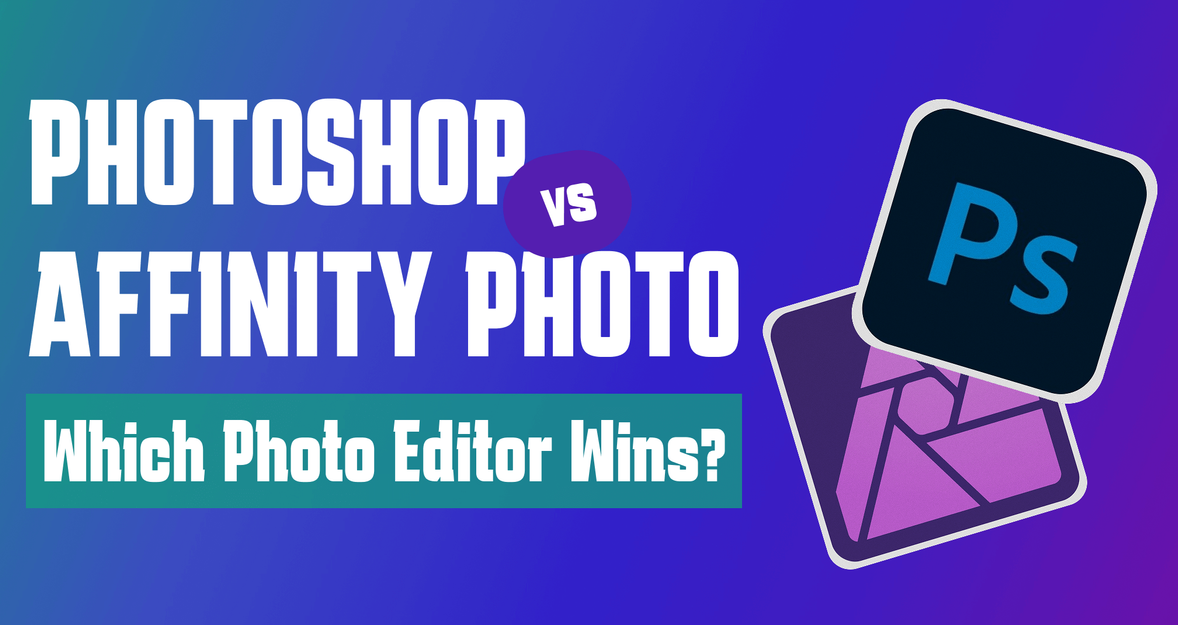Affinity Photo VS Photoshop: Delving Deeper
July 02, 2025

Affinity Photo vs Photoshop—discover the key differences between these top editing tools and find out which suits your creative workflow best.
We're sure you have heard hundreds, or thousands, of times, “Photography is art,” “Each shot is an emotion,” etc. Through photography, we can show others our worldview, share our emotions, inspire or surprise them.
With modern technology and AI editing tools, you can do things that used to be impossible or required a whole team and a big budget. Want to move your model from a boring backyard to a beach in Bali? Done. Add dramatic sunlight, tweak the shadows, or change the color tone? Easy.
But even with all these innovative tools, it’s easy to get lost. There are too many sliders, options, filters, and presets, and suddenly, you’re spending more time figuring out the software.
Why Choosing the Right Photo Editor Matters
 A good program helps bring out the best in your photos, while a poor one can slow you down, frustrate you, or even scare you off with its complexity or limitations.
A good program helps bring out the best in your photos, while a poor one can slow you down, frustrate you, or even scare you off with its complexity or limitations.
The choice of editor affects:
How fast and easy it is to edit your photos.
The final quality of your images.
Your creative possibilities.
Compatibility with other professional tools.
Photoshop is a famous tool. Even people who are not into photography have heard of it. Recently, more photographers have been discussing alternatives such as Affinity Photo, which is fast, less complicated than its competitor, and provides a sophisticated suite of powerful features.
So, what program should you use to edit your photos? This article will explain the differences between Photoshop vs Affinity without a technical overload.
Exclusive Tools of Endless Possibilities in One AI Editor
Explore Now!Interface and Ease of Use
Photoshop
 It is one of the best Adobe software programs, created in the late 1980s. It revolutionized digital photo editing and has become indispensable in the workflow of designers, photographers, and artists worldwide.
It is one of the best Adobe software programs, created in the late 1980s. It revolutionized digital photo editing and has become indispensable in the workflow of designers, photographers, and artists worldwide.
Photoshop has undergone many revolutions, making photo editing easier, simpler, and more enjoyable. Beyond its basic parameters, today's new versions include powerful AI tools like the generative fill, the remove tool, and the creative agent.
The interface is full of panels, menus, and options. You can reshuffle the panels, hide what you don’t need, and even change the color of the interface panel itself. Photoshop also lets you use keyboard shortcuts, tabs, separate windows for documents, and advanced layer controls for non-destructive editing.
Professionals appreciate being able to automate repetitive tasks with scripts and plugins, which can seriously speed up their workflow and improve results.
Affinity Photo
 Serif created Affinity Photo in 2015 as an affordable and easy-to-use competitor to Photoshop. Its modern and logical distribution of tools appeals to most beginners.
Serif created Affinity Photo in 2015 as an affordable and easy-to-use competitor to Photoshop. Its modern and logical distribution of tools appeals to most beginners.
Affinity Photo's interface is similar to Photoshop's—the layers are on the right, while the tools are on the left. You can also customize panels based on your workflow.
The first unique feature of Affinity Photo is "Personas"—special spaces that can be set up depending on the editing task, such as working with RAW files, retouching, or exporting. This keeps the layout less cluttered and directs you through the step-by-step editing process so you understand what you need to do at a time.
The second one is Live Filters, which lets you apply effects as separate layers. You can modify or disable these effects without damaging your original image. It is a practical solution for experimenting and learning as you go.
By the way, questioning “Can Affinity Photo open PSD files”? The answer is yes. The software is compatible with weaker computers and can handle big files and PSD documents.
While some advanced features and third-party plugins are limited compared to Photoshop, Affinity is still quicker for everyday edits.
Features and Capabilities
Photoshop
 The best part is that the editor can process RAW files. Photoshop’s built-in Camera Raw tool lets you change the light, color, and sharpness without compromising quality.
The best part is that the editor can process RAW files. Photoshop’s built-in Camera Raw tool lets you change the light, color, and sharpness without compromising quality.
Thanks to Adobe’s AI technology, several tasks that previously took a lot of time are simpler to handle today. For example, the Generative Fill feature uses prompts. Choose a part of your photo and describe what you want to add or remove. Photoshop will do the rest. This component lets you touch up photos without much time on detailed editing.
Photoshop has many plugins and scripts to automate dull jobs and save time. Creative Cloud, which is interoperable with Lightroom, Illustrator, and Premiere Pro, easily transfers work between programs. You can also edit 3D objects and videos.
Because of its popularity, numerous Photoshop tutorials are available online. In case you are stuck or want to learn something new, you have access to help and guidance easily. This support makes it easy to get used to even the more complex features.
Affinity Photo
 The software has many Adobe’s photo editor features and everything a photographer needs. You can work with layers, masks, adjustment layers, and custom brushes (including those you transfer from Photoshop). It also allows you to edit RAW files with its Develop Persona workspace, where you can fine-tune your images from the outset.
The software has many Adobe’s photo editor features and everything a photographer needs. You can work with layers, masks, adjustment layers, and custom brushes (including those you transfer from Photoshop). It also allows you to edit RAW files with its Develop Persona workspace, where you can fine-tune your images from the outset.
Affinity Photo supports HDR merging, panoramas, and focus stacking, working with professional color spaces like CMYK and LAB. It can effortlessly process massive images (even above 100 megapixels) and takes up much less space on the hard drive than Photoshop.
Live Filters is the best tool for adding effects as separate layers. They can also be adjusted or removed without damaging your original picture.
Unfortunately, Affinity Photo's automatic features are not as advanced as Photoshop's, and some tools are less comprehensive. It doesn’t support AI, video, or 3D editing. Nevertheless, Affinity Photo is still quite good for most photo editing and touch-ups, particularly if you do not intend to work with complex animations or video.
Price and Availability
Photoshop
 Even though the program is subscription-based, it still benefits its professionals with constant upgrades and support.
Even though the program is subscription-based, it still benefits its professionals with constant upgrades and support.
Photography Plan (Photoshop + Lightroom). For $19.99/month, you get Photoshop (desktop and iPad), Lightroom, Lightroom Classic, and 1 TB of cloud storage.
Photoshop Single App Plan. With $20.99 a month, you can access Photoshop on desktop and iPad and 100 GB of cloud storage.
Creative Cloud All Apps Plan. For $54.99/month, you can enjoy over 20 Adobe Creative Cloud Apps, including Photoshop, Illustrator, Premiere Pro, After Effects, etc. With it, one gets 100 GB of cloud storage.
All listed plans have a one-year commitment. Prices can differ depending on location, taxes, and currency variations. Please visit Adobe’s official site for the latest and most accurate information.
Affinity Photo
 As of 2025, a license costs about $70, depending on the region or during sales. Users who want the full Affinity V2 Suite (including Affinity Photo, Designer, and Publisher on all platforms) can purchase a universal license for $164.99 per lifetime.
As of 2025, a license costs about $70, depending on the region or during sales. Users who want the full Affinity V2 Suite (including Affinity Photo, Designer, and Publisher on all platforms) can purchase a universal license for $164.99 per lifetime.
For example, comparing Lightroom vs Affinity Photo, remember that Lightroom runs on a $9.99/month subscription, while Affinity Photo, you pay once.
Personal Use: Who Is Each Program Best For?
Photoshop
It concentrates more on professionals or people who want to take photography, design, or digital content creation seriously. Photoshop's greatest strengths are its cutting-edge technology, regular updates, massive array of plugins, and integration with numerous Adobe products. This editing software is also cloud-based and operates on multiple devices, which makes it flexible and offers sophisticated functions for complicated projects.
Affinity Photo
This is an excellent option for the amateur needing professional editing tools at a low cost without any ties to a subscription. This RAW photo converter has everything needed to edit high-quality photos, so one can learn to use the program relatively quickly. Affinity Photo is favored if you want a user-friendly, cheap alternative without worrying about a complicated system.
Function | Photoshop | Affinity Photo |
Price | Subscription (from $10/month) | One-time purchase (~$70) |
AI Features | Yes (Generative Fill, Enhance) | Not yet or limited |
PSD Support | Full | Partial |
Retouching | Professional-level | Excellent |
RAW Editing | Camera Raw | Built-in |
Interface | Flexible but complex | Modern and user-friendly |
Performance | Good, but resource-intensive | Fast and optimized |
Plugin Support | Extensive | Limited |
Free Trials
Both offer free trials so you can test them before paying. Affinity Photo provides a free test run of six months rather than the usual seven to thirty days. This means you can test all options without giving any payment information.
Photoshop has a 7-day trial from the Adobe Creative Cloud, which offers ample time to practice the basic functions. However, if you are new to editing, it may feel rushed.
Can't decide: Affinity vs Adobe? Try editing the same photo in both. See which interface and tools are the most convenient, and which working method inspires you to continue.
Bonus: What Is Luminar Neo and Who’s It For?
 Luminar Neo is an easy photo editor that lets you get great results with just a few clicks. It uses AI to help improve portraits, replace skies, remove distractions, and even relight scenes. It is perfect for newbies, content makers, or anyone tired of dull workflows.
Luminar Neo is an easy photo editor that lets you get great results with just a few clicks. It uses AI to help improve portraits, replace skies, remove distractions, and even relight scenes. It is perfect for newbies, content makers, or anyone tired of dull workflows.
Your AI-Powered Photo Editor for MacOS and Windows
Discover Now!Luminar Neo is available to Mac and Windows users. The program can be activated on two devices together, so you can work from home and on the go without buying a separate license. Skylum offers other creative packages, such as presets, overlays, sky textures, and video courses.
If you’re deciding between Luminar vs Affinity Photo, Skylum’s AI editor is simpler and beginner-friendly than its competitor.
Choose What Feels Right for You
Indeed, not everyone would enjoy the functionalities of the same photo editor. Photoshop has many features and is powerful and flexible, but it is challenging to learn and expensive. Affinity Photo is a lighter, modern, cheaper alternative with a smaller arsenal of advanced tools.
Don’t let the fear of learning something new hold back your creativity. When looking at Affinity Photo 2 vs Photoshop, remember that both programs have evolved to simplify editing work, rather than making it more confusing. After all, the software is basically a tool—the real creativity and vision always come from you.





